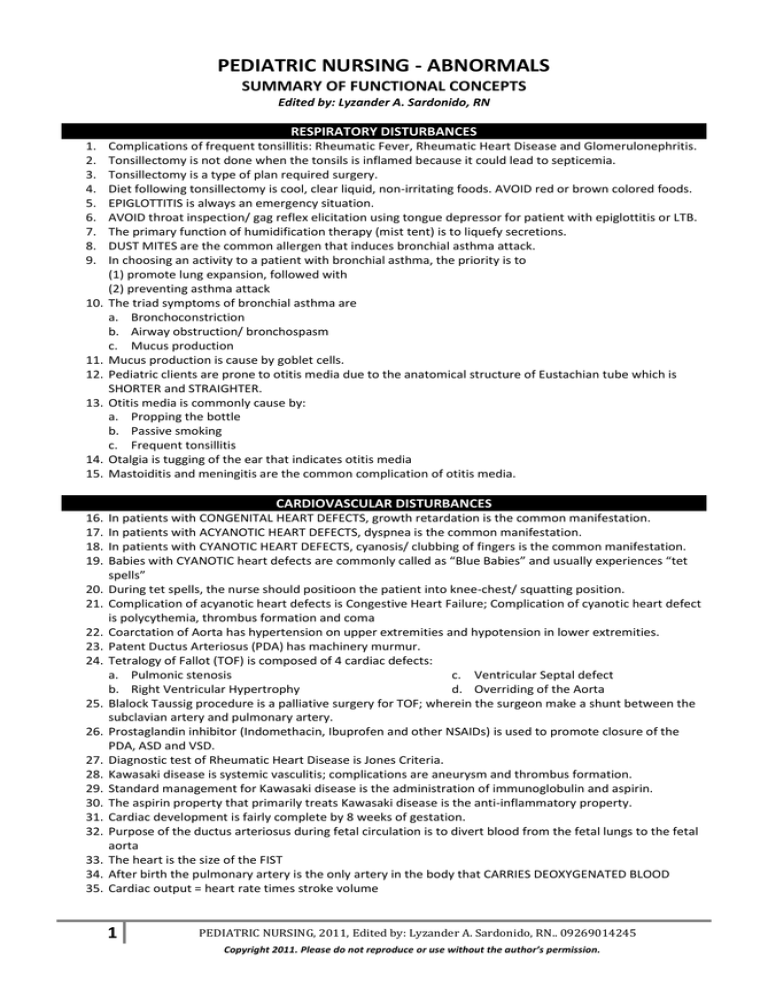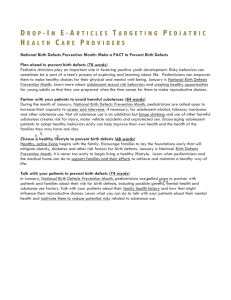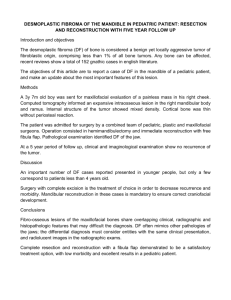File - zander nursing
advertisement

PEDIATRIC NURSING - ABNORMALS SUMMARY OF FUNCTIONAL CONCEPTS Edited by: Lyzander A. Sardonido, RN RESPIRATORY DISTURBANCES 1. 2. 3. 4. 5. 6. 7. 8. 9. 10. 11. 12. 13. 14. 15. Complications of frequent tonsillitis: Rheumatic Fever, Rheumatic Heart Disease and Glomerulonephritis. Tonsillectomy is not done when the tonsils is inflamed because it could lead to septicemia. Tonsillectomy is a type of plan required surgery. Diet following tonsillectomy is cool, clear liquid, non-irritating foods. AVOID red or brown colored foods. EPIGLOTTITIS is always an emergency situation. AVOID throat inspection/ gag reflex elicitation using tongue depressor for patient with epiglottitis or LTB. The primary function of humidification therapy (mist tent) is to liquefy secretions. DUST MITES are the common allergen that induces bronchial asthma attack. In choosing an activity to a patient with bronchial asthma, the priority is to (1) promote lung expansion, followed with (2) preventing asthma attack The triad symptoms of bronchial asthma are a. Bronchoconstriction b. Airway obstruction/ bronchospasm c. Mucus production Mucus production is cause by goblet cells. Pediatric clients are prone to otitis media due to the anatomical structure of Eustachian tube which is SHORTER and STRAIGHTER. Otitis media is commonly cause by: a. Propping the bottle b. Passive smoking c. Frequent tonsillitis Otalgia is tugging of the ear that indicates otitis media Mastoiditis and meningitis are the common complication of otitis media. CARDIOVASCULAR DISTURBANCES 16. 17. 18. 19. 20. 21. 22. 23. 24. 25. 26. 27. 28. 29. 30. 31. 32. 33. 34. 35. In patients with CONGENITAL HEART DEFECTS, growth retardation is the common manifestation. In patients with ACYANOTIC HEART DEFECTS, dyspnea is the common manifestation. In patients with CYANOTIC HEART DEFECTS, cyanosis/ clubbing of fingers is the common manifestation. Babies with CYANOTIC heart defects are commonly called as “Blue Babies” and usually experiences “tet spells” During tet spells, the nurse should positioon the patient into knee-chest/ squatting position. Complication of acyanotic heart defects is Congestive Heart Failure; Complication of cyanotic heart defect is polycythemia, thrombus formation and coma Coarctation of Aorta has hypertension on upper extremities and hypotension in lower extremities. Patent Ductus Arteriosus (PDA) has machinery murmur. Tetralogy of Fallot (TOF) is composed of 4 cardiac defects: a. Pulmonic stenosis c. Ventricular Septal defect b. Right Ventricular Hypertrophy d. Overriding of the Aorta Blalock Taussig procedure is a palliative surgery for TOF; wherein the surgeon make a shunt between the subclavian artery and pulmonary artery. Prostaglandin inhibitor (Indomethacin, Ibuprofen and other NSAIDs) is used to promote closure of the PDA, ASD and VSD. Diagnostic test of Rheumatic Heart Disease is Jones Criteria. Kawasaki disease is systemic vasculitis; complications are aneurysm and thrombus formation. Standard management for Kawasaki disease is the administration of immunoglobulin and aspirin. The aspirin property that primarily treats Kawasaki disease is the anti-inflammatory property. Cardiac development is fairly complete by 8 weeks of gestation. Purpose of the ductus arteriosus during fetal circulation is to divert blood from the fetal lungs to the fetal aorta The heart is the size of the FIST After birth the pulmonary artery is the only artery in the body that CARRIES DEOXYGENATED BLOOD Cardiac output = heart rate times stroke volume 1 PEDIATRIC NURSING, 2011, Edited by: Lyzander A. Sardonido, RN.. 09269014245 Copyright 2011. Please do not reproduce or use without the author’s permission. NEUROLOGIC DISTURBANCES 36. Common cause of neural tube defects: low folic acid (folate) intake during pregnancy 37. Common types of neural tube defect: (1) Spina bifida occulta and (2) spina bifida cystic (meningocele and myelomeningocele) 38. Priority management for Neural tube defect: (1) prevent trauma to the sac/ prevent injury and (2) prevent infection and complication 39. Priority management in patients with Neural Tube Defects is to prevent rupture of the sac. 40. Arnold-Chiari malformation (Chiari II malformation) by Julius Arnold, Hans Chiari: ACM is the overgrowth of cerebellum and medulla (neural tube) and pushed down through the foramen magnum, blocking flow of CSF. It is associated with myelomeningocele: it is manifested by, Stridor/ breathing difficulties, Weakness of Upper and lower limbs, and Swallowing difficulties. 41. Priority for seizure disorders is SAFETY. 42. Cerebral palsy is a permanent, non-progressive, motor function impairement. 43. Epilepsy is described as “recurrent seizure” 44. Post-op position for patient with hydrocephalus who underwent shunting procedure ois sidelying to the unopperative site or low fowler’s position (up to 30 degrees ONLY) 45. Patient with Increased Intracranial pressure has the following vital signs: (1) Increased BP (2) Decresaed RR and PR (3) Widening pulse pressure GASTROINTESTINAL DISTURBANCES 46. Priority management in patients with cleft lip and cleft palate following surgery is to prevent rupture of the suture line. 47. In pyloric stenosis, frequent, projectile, non-bile stained vomitus is a common manifestation. 48. In pyloric stenosis, there is no bile in the vomitus because the obstruction is above the ampulla of Vater (duodenal ampulla). 49. Surgery for pyloric stenosis is pyloromyotomy (Fredet Ramstedt procedure) 50. The 3 classical signs of intussusception are: (1) intermittent abdominal pain (2) currant jelly stool, and (3) sausage-shaped mass. 51. The surgical intervention for intussusception is hydrostatic reduction surgery using enema (barium or airwater) and/or resection and anastomosis. 52. Hirschprung’s disease (Aganglionic Megacolon) is manifested by pellet-like stools/ ribbon like stools/ constipation. 53. The common cause of death in a child with cystic fibrosis is respiratory problem. 54. Foods to be AVOIDED by a patient with celiac disease (celiac sprue/ gluten-sensitivity enteropathy) are Barley, Rye, Oats, and Wheat. 55. Foods that are ALLOWED by a patient with celiac disease are white rice, potatoes and corn. 56. Newborns and infants have a 10- to 20-milliliter stomach capacity at birth 57. Infants can absorb the fat in breast milk more readily than fat in formula because human breast milk contains lipase 58. During the newborn assessment, the nurse will examine the palate by palpation with a gloved finger 59. ESSR stands for Enlarge, Stimulate, Swallow, and Rest. ESSR is the international feeding method for cleft lip and cleft palate patients. 60. Tracheoesophageal atresia with esophageal atresia, signs: (1) Chocking (2) Coughing (3) Cyanosis GENITORINARY DISTURBANCES 61. Wilm’s tumor (nephroblastoma) is a kidney cancer in children. The tumor is usually unilateral, palpable, painless, soft, abdominal mass. 62. Bilateral tumor and dyspnea are manifestation of late signs of Wilm’s tumor. 63. Priority in Wilm’s tumor: “DO NOT PALPATE” 64. Wilm’s tumor is the 2nd most common cancer in children. 65. Common complication of crytorchidism is sterility or testicular cancer. 66. Epispadias has dorsal opening in the meatus and associated with exstrophy of the bladder. 67. Hypospadias has ventral opening in the meatus and associated with chordee. 2 PEDIATRIC NURSING, 2011, Edited by: Lyzander A. Sardonido, RN.. 09269014245 Copyright 2011. Please do not reproduce or use without the author’s permission. 68. Chordee is abnormal downward curvature of the penis. 69. Corrective surgery for epispadias and hypospadias is done BEFORE toilet training. 70. 4 Hallmark manifestations of Nephrotic syndrome (Nephrosis): (1) Proteinuria (3) Edema (anasarca) (2) Hypoproteinemia (4) Hypercholesterolemia MUSCULO-SKELETAL DISTURBANCES 71. In Bryant’s traction, make sure that the buttocks are off the bed. 72. Priority nursing diagnosis in a patient with skin traction is Impaired Skin Integrity. 73. Developmental hip displasia (DHD)/ Congenital Hip Dislocation (CHD) is the separation of the femoral head from the acetabulum. 74. Priority management for DHD: ABDUCT the affected leg 75. Management for scoliosis: Milwaukee brace and Harrington rod instrumentation. 76. Fat is stored inthe yellow marrow of the medullary cavity of the bones 77. Hematopoiesis occurs in the red marrow of the medullary cavity of the bone. 78. In cervical traction, the head of the bed be elevated by 20-30 degree. 79. Treatments used for compartment syndrome are split the cast if one is present or do a fasciotomy to relieve pressure. 80. An early sign of compartment syndrome is the sudden inability of the medications to relieve pain HEMATOLOGIC DISTURBANCES 81. To prevent sickle cell crisis, avoid 3 things: (1) hypoxia/ respiratory acidosis, (2) metabolic acidosis, and (3) dehydration 82. The priority management in sickle cell anemia is: (1) Hydration (2) Oxygen (3) Pain management 83. Iron supplements should be given before meals to promote proper absorption of the gastric acidity except for ferrous sulfate because it is irritating to the stomach. 84. BLEEDING PRECAUTION is composed of P.E.C.A.T: Pressure site, Elevate above the heart, Cold compress, Arterial pressure, Tourniquet. 85. Hemophilia A and B is X-linked inherited. 86. Leukemia is the MOST COMMON cancer in children. 87. CHEMOTHERAPY is the best treatment modality is pediatric oncology. 88. During fetal development, blood cells produced in the liver and spleen 89. Features of red blood cells (RBCs) allow them to reach all the tissues of the body: shape, size, and structure 90. The most common blood disorder in children is ANEMIA INTEGUMENTARY DISTURBANCES 91. To prevent diaper rash, the best is to use absorbent diapers. 92. Permethrin (Nix) is the drug of choice for Pediculosis capitis. 93. Lindane (Kwell) is used commonly for scabies. It must be avoided below 2 months of age because Lindane is neurotoxic. 94. Classic sign of impetigo is honey-colored crusts on the skin 95. Staphylococcus aureus is the common cause of bullous impetigo CHILD ABUSE AND NEGLECT 96. CHILD MALTREATMENT is the intentional injury of a child 97. Physical abuse is the bodily injury to a person that seems to have been inflicted by other than accidental means 98. The majority of perpetrators of abuse to children are PARENTS 99. The most common type of mistreatment of children is NEGLECT 100. According to the social-interactional systemic perspective of child abuse and neglect, four factors place the family members at risk for abuse. These risk factors are (1) the family itself (3) the child (2) the caregiver (4) the presence of a family crisis 3 PEDIATRIC NURSING, 2011, Edited by: Lyzander A. Sardonido, RN.. 09269014245 Copyright 2011. Please do not reproduce or use without the author’s permission.




